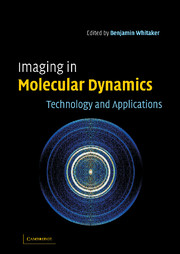Book contents
- Frontmatter
- Contents
- List of contributors
- Preface and acknowledgements
- List of abbreviations
- Part 1 Technology
- 1 Charged particle imaging in chemical dynamics: an historical perspective
- 2 Velocity map imaging: applications in molecular dynamics and experimental aspects
- 3 Reconstruction methods
- 4 Orientation and alignment
- 5 Time resolved cameras
- 6 3-D Imaging technique – observation of the three-dimensional product momentum distribution
- 7 Photoelectron and photoion imaging with femtosecond pump-probe time clocking
- Part 2 Applications
- Index
2 - Velocity map imaging: applications in molecular dynamics and experimental aspects
Published online by Cambridge University Press: 07 August 2009
- Frontmatter
- Contents
- List of contributors
- Preface and acknowledgements
- List of abbreviations
- Part 1 Technology
- 1 Charged particle imaging in chemical dynamics: an historical perspective
- 2 Velocity map imaging: applications in molecular dynamics and experimental aspects
- 3 Reconstruction methods
- 4 Orientation and alignment
- 5 Time resolved cameras
- 6 3-D Imaging technique – observation of the three-dimensional product momentum distribution
- 7 Photoelectron and photoion imaging with femtosecond pump-probe time clocking
- Part 2 Applications
- Index
Summary
Introduction
This chapter aims to introduce you to the practical aspects of molecular dynamics research using imaging methods. Imaging is a rapidly advancing experimental technique full of possibilities. This puts you in position to make unique and important contributions to the field of reaction dynamics, and you will be the first person to see the secrets of nature appear on your camera screen. Every scientist lives in part for this exciting result and velocity map imaging more than any other method presents the full picture in living color!
Velocity map imaging is the present day variant of the ion imaging method invented by David Chandler and Paul Houston in 1987 [1]. We discovered the advantages of a simple electrostatic lens for the ion imaging method in 1997 [2]. The improvement was so dramatic that David Chandler convinced us to give it the new name, velocity map imaging. Undoubtedly, you or some other clever scientist will discover a new trick to make imaging work even better in the future. Imaging has much to offer in present-day molecular dynamics research, as illustrated in this chapter. This introduction will lead to the following chapters in this book on experimental aspects, data analysis, angular momentum theory, photoionization, and alternative methods.
- Type
- Chapter
- Information
- Imaging in Molecular DynamicsTechnology and Applications, pp. 20 - 64Publisher: Cambridge University PressPrint publication year: 2003
- 1
- Cited by

